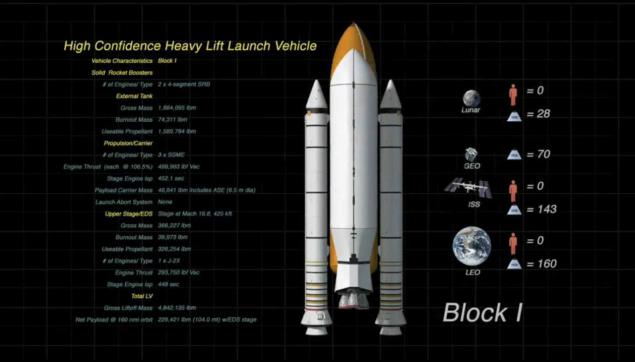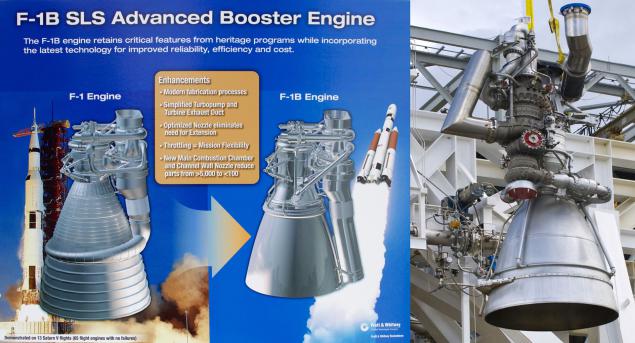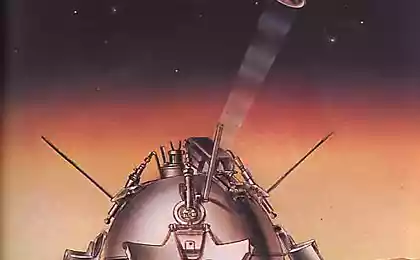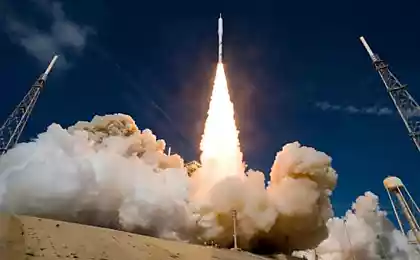3518
Chronicle sverhtyazhelovesov space. Part 3. "Marstodonty" new era

In 1984, NASA became apparent that the system of the Space Shuttle is not able to carry out the planned 20 annual launches stated in the original project. The search for alternative solutions has led to the first paper on the creation of more budget options for space systems.
The crash of the shuttle Challenger in 1986, became the catalyst for the beginning of the transformation of the universal system, albeit only in the drawings, in extra heavy moon rocket.
As we know from the previous part of the review, the Space Shuttle Orbiter with the help of its main engines RS 25 use an external fuel tank on the main segment of acceleration of the space system. Through this Orbiter weighing about 100 tons left on the Earth's orbit. As we know from the experience of Soviet engineers, converted reusable systems OS 120 (technical copy Shuttle) in the "energy-Buran" that such a scheme permits to convert reusable systems in extra-heavy carrier rocket at relatively low costs.
Start designing super-heavy carrier rocket «Shuttle C» in October 1987, was the first step in this direction.
In fact it was almost the same system, but from the Orbiter were only 3 sustainers (RS 25) and 2 shunting (OMS) engine, let loose weight RN «Shuttle C» injected into Earth orbit up to 77 tonnes of payload. Thus, NASA had hoped to cover a one-year plan for the launch of the space shuttle (output at a time not more than 25 t), as well as the use of new media to the launch of large space stations and large optical telescopes.
The scheme RN «Shuttle C», the right-size mock-up booster C i>

The cost of the entire scope of work was estimated at $ 2 billion, which is approximately equal to the cost of the new Orbiter. By the early 90s, despite this relatively low amount of NASA and could not determine the goals for the new perspective RN. 2 billion has been spent on new orbiter Endeavour, and in the construction of space stations, it was decided to rely on the support and experience of Russia ("Mir - Atlantis», «ISS"). Project «Shuttle C» in 1995, has been postponed pigeonholed. As it turned out not to long.
In 2003, the world is shaken by another cosmic catastrophe. On returning to Earth with the ship Columbia was lost his entire crew of 7 astronauts. Ironically, it was the shuttle at the end of the 80th offered to remake the second stage rocket «Shuttle C». NASA and the US leadership became apparent that the space shuttle era comes to an end sooner than they expected. It was decided to rethink not only technical, but also an ideological strategy of the US space program.
This resulted in an ambitious program of "Constellation", announced in 2004. The program was supposed to re-use developments under the program «Space Shuttle», but in contrast to the «Shuttle C», significantly increased capacity solid rocket boosters (pull both accelerators brought to 1700t! Each). GWS blocks separated by 116 seconds after launch. External fuel tank increased in diameter from 8 to 10 m, and 3 sustainer engine RS 25 are replaced by 5 more simple RS 68 from PH Delta 4 (thrust 350t each), which were already transferred under the fuel tank itself (similar to the block C "Energia» ). Through the 303 seconds of the above-described first stage rocket separated, and then the second step of the armed motor J 2X (second modification of the engine and the third stage «Saturn 5") vyvodila into orbit with the lunar module "Altair».
RN «Ares 5" with the Altair lunar module i>

Superheavy RN was named Ares 5, the name "Ares" means the principal objective of the RN - manned expedition to Mars (the Romans called Mars Greek god of war Ares). A number 5 has referred to the famous moon rocket Saturn 5. Ares 5 was able to output into low Earth orbit payload 188t (70t or more of the orbit of the Moon).
In parallel with this used heavy RN Ares 1 wherein the first stage was one unit TRU (SRB) Ares pH 5, and the second stage as well armed engine J 2X. Ares 1 launch into orbit a manned spacecraft "Orion", which after docking with the lunar module "Altair" accelerated the trajectory to the Moon second stage of the rocket Ares 5. Name the same index refers to the RN «Saturn 1 / B», used to run manned spacecraft "Apollo" in 60-70yh years.
Device RN «Ares 1» i>

The test launch rocket «Ares 1", 2009. Closure of the project forced NASA to use Russian "Soyuz" for delivering astronauts to the ISS i>
In 2009, the newly proposed the concept of the project «Shuttle C» (renamed HLLV), some modifications which lets you run into orbit for about 100t)

However, NASA rejected this project, and a year later - in 2010, at the peak of the global financial crisis, and the program will be canceled "Sozvezdia international».
In 2011, based on the Constellation project, it was decided to create a "lite" version of both the super-heavy rocket Ares 5 and manned spacecraft Orion.
The new missile SLS (Space Launch System - «Space Launch System") is much less than the base system «Space Shuttle», rather than Ares 5. As to the original 4 sections TRU added fifth segment. The parameters of the external fuel tank practically remained the same (with a diameter of 8, 4 m). By analogy with the central unit "energy" instead of the three main engines, the fuel tank under the original space shuttle engine installed 4 RS 25D / E. However, unlike the "energy" and «Shuttle C», derivable load placed on, and not sideways. The payload reached the same 70t (Box 1) that of the «Shuttle C». Weight pH increased to 3000t, height was 121m, the total thrust at start - 4000t (3200t in total thrust two blocks TRU + 740t traction 4 RS 25). Such excess thrust towards Payloads (even 130tonnoy block version 2), due to the very low specific impulse blocks TRU (265s).
The scheme RN «SLS» block 1 i>

It is planned to enhance the thrust-«SLS» to 105 (unit 1A) and 130 m (Block 2), respectively, for first lunar and then manned interplanetary missions. The cost of the project by 2017 is estimated at $ 35 billion. Willingness RN «SLS» estimated at 70%, the first flight is scheduled for 2017.
Different versions RN «SLS» i>

Another historical curiosity. NASA has announced a tender for the purchase of advanced LRE engines for future versions RN «SLS» (in particular block 2), because of the above-mentioned low-y. pulse units TRU. Along with offering a modified version of engine Rocketdyne F 1 rocket «Saturn 5» (F 1B with increased thrust from 690 to 800 MT), the struggle has entered a private space company Aerojet engines AJ 26. The irony is that the AJ 26 is a modification of the American engine ... NC 33, developed in his time already for the Soviet lunar rocket H 1. The tender ends next year, and a new duel old rivals for a place in the new moon rocket promises to be hot. However, it is possible that NASA will adopt both engines.
Concept F 1B (left) and NC 33 / AJ 26 on the test stand firm Aerojet (right) i>

In the year of the closing of the "Constellation", June 4, 2010, a private company based Space X Elon Musk, launched the enhanced version of the series rocket Falcon - «Falcon 9". Despite the fact that even a modified version of «Falcon 9 1.1" is not allowed to carry a payload weighing more than 14t (a little less "Zenit"), but in 2012, Space X has announced a contract with the US Department of Defense at the start of extra-heavy version «Falcon Heavy "in 2015.
Elon Musk on the background PH «Falcon 9 1.0." Clearly visible 9 Merlin 1C engines located "squares» i>

It uses the packet diagram rocket design with three blocks «Falcon 9 1.1" for the first and second stage, armed with 9 enhanced engines Merlin 1D each. The third stage is armed with one engine Merlin 1D is used to disperse the load on the Earth's orbit (5 in the diagram below). A total of 27 engines at startup develop a thrust of 1800t at y. pulse to 282c. The diameter of each unit - 3, 6 m, height of the rocket - 68 m, weight - 1460t, the mass output of payload into low Earth orbit - 53t, at the price of launching a $ 100 million. In the future we plan to reuse blocks of the first stage.
The scheme RN «Falcon Heavy», three modules of the first stage of the launch «Falcon 9 1.1" has 9 engines Merlin 1D (lower right) each. It may be noted characteristic "circular" arrangement of the main engines RN «Falcon 9 1.1» i>

According to plans of Space X, the main purpose of this carrier - a demonstration of best means of implementing a manned expedition to Mars ( program "Red Dragon" < / a> and «Mars One» ).
Modular "colleague" RN family «Falcon» - Russian rocket "Angara" development RSC "Energia" and NGO "Energomash" just theoretically capable orbit loads up to 50t. Version rocket A7 2B completed 6 base and one block gain URM 1 armed RD 191 each. 7 engines must develop a total thrust when starting in 1400t. To disperse the payload to Earth orbit using block third stage KVTK2 with RD 0124. Mass project RN - 1200T, height - 65m. However, even for the version of "Angara A7" with lifting capacity 35t have to build a separate table and start over the next 10 years will be mainly used in assembly A1 to A5 capacity from 1, 5 to 25t.
Various compositions blocks URM 1 RN "Angara» i>


Projects as a separate superheavy pH is in Russia infancy . Though our country and has all the necessary means for this (family of light (RD 191 / SC 33) and heavy (RD 171 / M) high efficiency motors), a particular problem for a RN yet. But things can change quickly, not only against the background of the American success of projects and SLS «Falcon Heavy», but also works in this direction our eastern neighbors.
The hypothetical option of extra heavy Russian rocket "Yenisei 5" borrows largely on developments rocket "Energy", namely the Upper Stage 4 of the first stage with the RD 170 and hydrogen engines of the second stage of RD 0120 (the latest production recovery remains a big question i>

In China, with 2013, at the design stage of work is the future superheavy carrier "Long March 9". Chinese engineers are actively engaged in the development of oxygen / kerosene engine YF 660 Homepage thrust 650t. Four such plan to use at the first stage of the launch (or 4 blocks GWS with a thrust of 1000 tons each).
The technological layout experienced engine YF 650 (left) and a diagram of the engine YF 220 (right) i>

The second stage will also be armed with x4 YF 660 (version A) or x5 YF 220 (version B), and the third two (version A) or one (version B) engine thrust YF 220 200t. The mass of the rocket is estimated at 4000t, traction when starting in 5000t, length of 100m and a 130t payload. The main task of the new RN called the beginning of human colonization of our natural satellite - the Moon.
CR "Long March 9" version of A (left) and B (right) i>

We can only wish good luck to all the participants of a new race of superheavy carriers, and hopes that this time the great march of human space will be the beginning of full-scale human exploration of the solar system.
Moon Part 1 "dinosaurs».
Part 2. "Park" reusable period.
Source: habrahabr.ru/post/229519/
Recognition of individual beauty
Astronomers finally convinced to exit Voyager 1 in interstellar space























